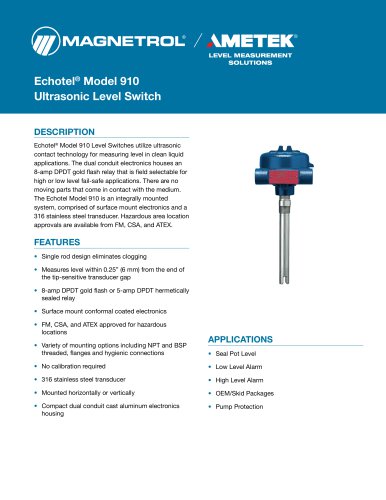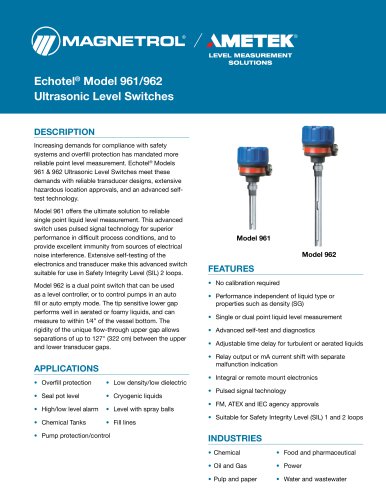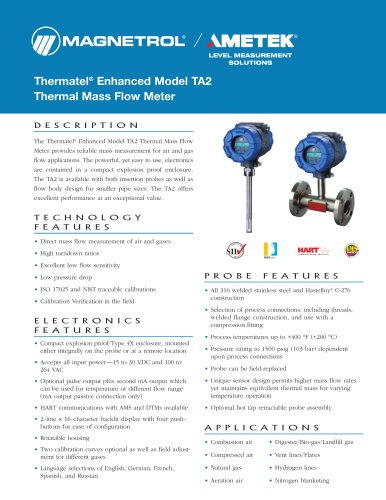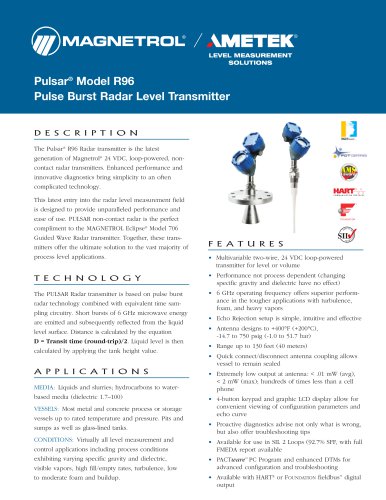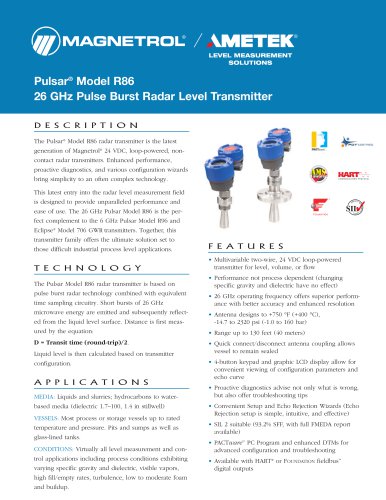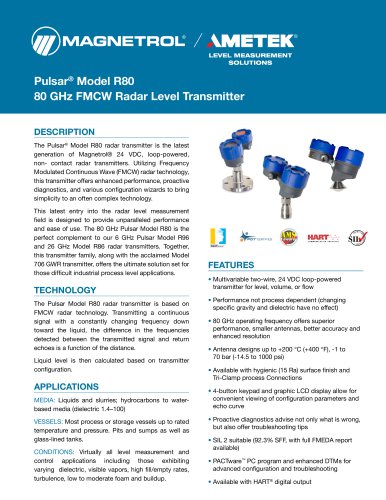 Website:
Magnetrol - AMETEK
Website:
Magnetrol - AMETEK
Group: AMETEK
Oil & Gas Field Processing - A Guide for Level Instrumentation for Oil & Gas Field Processing
1 /
12Pages
Catalog excerpts

I N D U S T R Y A P P L I C A T I O N S S E R I E S A Guide to Level Instrumentation for Oil & Gas Field Processing
Open the catalog to page 1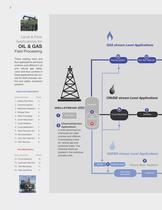
These leading level and flow applications are found onshore and offshore in oil and natural gas fields. Level and flow controls in these applications are crucial for both process control and safety shutdown systems. Liquid Level Applications: APPLICATION PAGE 1. Drilling Fluid Tanks 4 2. Chemical Injection 4 3. Well Stream Separator 5 4. Storage Tanks 5 5. Water Processing 6 6. Crude Dehydration 6 7. Crude Desalting 7 8. Crude Stabilization 7 9. Vapor Recovery Unit 8 10. Gas Dehydration 8 11. Sour Gas Treatment 9 12. NGL Recovery 9 Flow Applications: APPLICATION PAGE 13. Pump Protection 10...
Open the catalog to page 2
Pumps & Compressors* Tank Blanketing Flare Operations FIELD PROCESSING SCHEMATIC To injection well To export pipeline To disposal To reservoir Flow Applications for GAS, CRUDE and WATER Secondary Water Treatment Liquids and Gases** Stabilization Vapor Recovery NGL Recovery NGL Storage Crude Collection and Storage Tanks 4 4 5 8 9 12 13 14 15 16 The instruments recommended in this guide are based on field experience with similar applications and are included as a general guide to level and flow control selection. Because all applications differ, customers should determine suitability for...
Open the catalog to page 3
Application: A cement slurry prepared on location (or trucked in) cements the well casing. Drilling fluids lubricate the drill bit, remove cuttings, prevent open wellbore collapse and maintain hydrostatic equilibrium for blowout protection. Water- and oil-based “muds” are used. Dispersants, flocculants, surfactants and rust inhibitors may be added to the drilling fluid. Challenges: Drilling fluids are typically stored in a series of partitioned, rectangular steel tanks. The tank fluid volume should be continuously monitored since level variations may indicate a pending blowout. Tank...
Open the catalog to page 4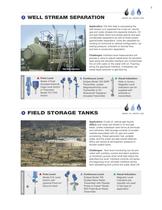
Application: The first step in processing the well stream is to separate the crude oil, natural gas and water phases into separate streams. Oil and gas fields utilize two-phase gas/oil and gas/ condensate separators as well as three-phase gas/oil/water separators. Units are classified according to horizontal or vertical configuration, operating pressure, turbulent or laminar flow, and test or production separation. Challenges: Interface level measurement will actuate a valve to adjust vessel level. An emulsion layer along the oil/water interface can contaminate the oil with water or the...
Open the catalog to page 5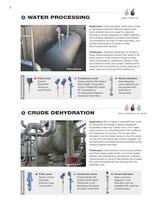
Application: Produced water, wash-down water or rainwater (collected offshore) require treatment whether they’re re-used for reservoir flooding or simply disposed of. Water collected from process operations contains hydrocarbon concentrations too high for safe discharge. Suspended hydrocarbon droplets in water also hinders well-injection. Challenges: Treatment equipment is similar to three-phase separators except that water is the main product. Level control is found on skim tanks, precipitators, coalescers, flotation units, and collection tanks and sumps. Interface level measurement is...
Open the catalog to page 6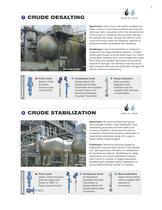
Application: Salt in the crude stream presents serious corrosion and scaling problems and must be removed. Salt is dissolved within the remnant brine of the crude oil. Desalting removes both salt and the residual free water. Though the refinery is the most economical place for desalting, pipeline requirements often necessitate field desalting. Challenges: Level instrumentation is integral to single and two-stage desalting systems, multiple orifice plate mixers, and the settler tank of a chemical desalter. Interface level control keeps free water from hitting the desalter electrodes and...
Open the catalog to page 7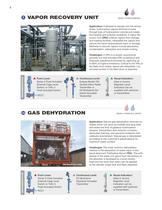
Application: If allowed to escape into the atmosphere, hydrocarbon vapors diminish income through loss of hydrocarbon volume and create fire hazards and pollution problems. A Vapor Recovery Unit (VRU) collects vapors from storage and loading facilities, reliquefies the vapors and returns the liquid hydrocarbons back to storage. Methods to recover vapors include absorption, condensation, adsorption and simple cooling. Challenges: A VRU is a simple, economical process unit that provides EPA compliance and improves operating economies by capturing up to 95% of fugitive emissions. Critical to...
Open the catalog to page 8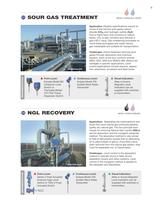
Application: Pipeline specifications require removal of the harmful acid gases carbon dioxide (CO2) and hydrogen sulfide (H2S). H2S is highly toxic and corrosive to carbon steels. CO2 is also corrosive and reduces a gas’s BTU value. Gas sweetening processes remove these acid gases and make natural gas marketable and suitable for transportation. Challenges: Amine treatment removes acid gases through absorption and chemical reaction. Each of the four common amines (MEA, DEA, DGA and MDEA) offer distinct advantages in specific applications. Level control applications include reactors,...
Open the catalog to page 9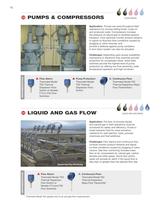
Application: Pumps are used throughout field operations for moving drilling fluids, crude oil and produced water. Compressors increase the pressure of natural gas to facilitate pipeline transport. Flow switches monitor product streams to signal no-flow/low-flow conditions caused by plugging or valve closures, and provide a defense against pump cavitation. A shut down system can also be actuated. Challenges: Depending upon power availability, mechanical or electronic flow switches provide protection for compressor skids. Solid state switches provide the highest level of pump protection by...
Open the catalog to page 10
11 Application: Nitrogen is commonly used as a tank blanketing gas in order to prevent ignition of flammable liquids, provide an oxygen and moisture barrier, inhibit vapor loss and maintain a tank’s pressure balance. Nitrogen is the leading gas used for tank blanketing applications. Nitrogen systems are prominent because they are simple to use and require little or no maintenance. (Also see Level Application #4 on page 5.) Challenges: Mass flow measurement will monitor the nitrogen blanketing gas. A mass flow meter can track usage as a cost control measure and determine the when, where and...
Open the catalog to page 11All Magnetrol - AMETEK catalogs and technical brochures
-
TUFFY® II
12 Pages
-
E4 Modulevel®
12 Pages
-
Thermatel® TD1/TD2
16 Pages
-
Crude Oil Processing
8 Pages
-
Natural Gas Processing
12 Pages
-
Interface In The Field
14 Pages
-
Emulsion In The Field
9 Pages
-
PRODUCT LINE CATALOGUE
106 Pages
-
Aurora® Magnetic Level Indicator
28 Pages
-
Atlas™ Magnetic Level Indicator
24 Pages
-
STEAM DRUM LEVEL MATTERS
1 Pages
-
INTERFACE IN THE FIELD
1 Pages
-
Echotel® 355
4 Pages
-
Power Generation
16 Pages
-
Petroleum Refining
16 Pages
-
Seal Pots
4 Pages
-
Mass Flow Measurement
12 Pages
-
Heat Rate Awareness
8 Pages
-
Ethylene Applications
8 Pages
-
GEMINI™
32 Pages
-
Eclipse® Enhanced 705 Hygienic
12 Pages
-
Pneumatic Tuffy®
12 Pages
-
Models T5x & T6x
8 Pages
-
Models T20/T21
12 Pages
-
Series B73 and Series 75
12 Pages
-
Series 3
24 Pages
-
Model J52
2 Pages
-
Model B40
4 Pages
-
Floating Roof Detection
16 Pages
-
APM Pneumatic Modulevel®
12 Pages
-
Flue Gas Desulferization
8 Pages
-
Energy Management
4 Pages
-
API 2350 Overfill Prevention
8 Pages
-
PULSAR ® R96
1 Pages
-
Water & Wastewater
12 Pages
-
Displacer Switches
20 Pages
-
Displacer Transmitters
4 Pages
-
Guided Wave Radar
12 Pages
-
Magnetic Level Indicators
12 Pages
-
Thermal Dispersion
12 Pages
-
Ultrasonic Contact
4 Pages
-
R Series High Temp Switch
12 Pages
-
Series K Pneumatic Switch
8 Pages
-
J Series Pneumatic Switch
8 Pages
-
Liquid Displacer Level Switches
16 Pages
-
Crude Oil Processing
8 Pages
-
Product Line Quick Reference
8 Pages





